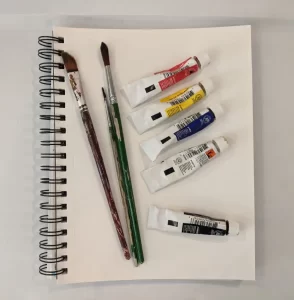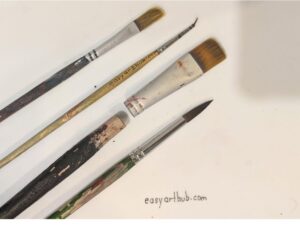In this post, I will discuss the common and the not-so-common painting surfaces you can paint with acrylic paint.
Stretched canvas and panels are the most commonly used surface for acrylic painting. Other surface options are paper, leather, rock, glass, and a lot more. Some surfaces will require special preparation/s while some will just need priming.

~This post contains affiliate links.
Traditional painting surfaces
Canvas and panels are commonly used surfaces for acrylic painting. Although paper may not be considered a traditional painting surface by some, I included it here since most aspiring artists can benefit from using them.
Canvas
Canvas is a traditional painting surface. They are perfect for acrylic paint as they have enough grit and absorbency. They usually come either rolled or stretched (framed).
Rolled Canvas
Rolled canvases are usually made of cotton or linen. They are available in the store primed or unprimed. As the name suggests, they are rolled like how typical fabrics are sold.
They are cheaper than stretched canvas since they don’t have the material and labor cost of the framing. They are also easier to store.
Some experienced artists prefer painting on rolled canvas. This way they don’t waste time and materials framing in case they end up not liking the finished art. It also gives them more freedom to crop the portion they like.
Rolled canvas is more cost-efficient to ship rolled artwork than a framed one. It is also less fragile.
Stretched Canvas
Store-bought stretched canvases are stretched and attached to a frame. They are usually pre-primed. They are great for beginners as they can be painted directly and displayed as it is.
A disadvantage is that they take up a lot of space and are not very compact. It is also not as sturdy as wood panels or boards.
Professional artists tend to prefer stretching and priming their own canvases to suit their needs. Some prefer to work on bare canvas, depending on their style.
Choosing the canvas for acrylic painting
For beginners, I recommend starting with a decent quality store-bought stretched canvas. You can paint them directly without needing to buy gesso primer.
You know a decent quality canvas if it has a good frame structure and is not flimsy. The canvas is thick enough and wrapped tightly and properly, with no tears or loose corners.
When you have more experience, you can buy the best quality and most expensive canvas like linen. Or even roll and prime your own canvas.
Preparing a stretched canvas
Since you don’t need to worry about framing and priming with a primed stretched canvas, there’s only one thing you need to add, the “keys”.
The canvas “keys” are the little wood pieces that usually come with a store-bought canvas. They are supposed to be inserted in those little holes at the back of the canvas. This will prevent the canvas from sagging in the middle. Especially important when working with a large canvas.
Most beginners skip this step. I’m guilty of this, as I was just too excited to start painting.
In the painting below, I didn’t put the keys before painting the 18 x 24” canvas. The canvas starts sagging and comes too close to the wooden support at the back. You will notice the ‘cross mark’ where the middle support of the frame is.

Wood Panels
Pros and cons
Panels made of wood or composites(like MDF or masonite) are also good surfaces for painting. Similar to stretched canvas, they can be displayed right away once the artwork is done.
As you might imagine panels are usually heavier than canvases, making them more costly to transport.
One might also need a sturdy shelf or rack to store large wood panels. But because they are less fragile compared to stretched canvas, you don’t need to worry much about sagging or getting ripped.
With some tools and elbow grease, panels can be cut into different sizes. They are usually a cheaper option than stretched canvas. They are also much more durable.
Most beginners also find it easier to paint rigid surfaces than bouncy(e.g. stretched canvas) ones.
Preparing a wood panel
Raw wood can be rough, prone to discolor, and is very absorbent. Thus, they need to be treated (sanded and sealed) prior to priming. This makes the acrylic paint dry a bit longer. While this can increase the wait time(to dry), it makes it easier to wipe off paint to correct mistakes.
Paper
Pros and cons
For beginners, I recommend getting a pad of watercolor or acrylic paper.
Even if you are already painting on canvases, having a small pad as a sketchbook is not a bad idea. You can take it anywhere and paint when inspiration comes. It’s a great way to practice a few techniques at a time without being overwhelmed.
Paper can be ripped into smaller pieces to make miniature paintings, greeting cards, or tags.
Paper is easy to store or ship compared to canvases and panels. Which is a big deal if you move or travel a lot. Finished artwork on paper is best displayed in a matted frame.
One disadvantage of paper is that it will not be able to support large and/or thick textured paintings.
Options
Watercolor/ acrylic / mixed media paper can be painted with acrylic paint. I find that 300 gsm or heavier paper can support acrylic paint.
Preparation
Paper can be primed or not depending on the artist’s preference. Paper can be stretched using painter’s tape to avoid warping.

Unconventional painting surfaces
Below is a list of surfaces that I’ve tried painting with acrylic paint. As I learned along the way, some require more preparation than others.
This is far from a comprehensive list. My goal here is just to give an idea of the wide variety of surfaces you can try.
Bags
May it be made of canvas, leather, or synthetic material, bags can usually be painted with acrylic.
Bags that have a solid structure can be painted just like a canvas. Those that don’t have a solid structure and are made of fabric can be painted like fabric.
If the surface has a protective coating, prior sanding can help the paint stick.
Cardboard
Bare cardboard (no gloss coating) can be painted with acrylic paint after priming. It’s good for practice or when doing fun upcycling.
Ceramics
Pottery items can be painted with acrylic paint after priming with gesso.
Note: Acrylic paint are not food safe paint. Do not use it to paint dishwares that will be in contact with food nor wash in the dishwasher.
Fabric
Acrylic paint mixed with a textile medium can be used with fabric. Textile medium helps with binding and prevents the cracking of the paint by making it flexible. The latter is very useful when applying thick paint on surfaces that fold or get crumpled.
If you are planning to apply thinner or watery paint, sort of like a dye, you can just add a bit of vinegar as a fixative instead of textile medium.
Indirect ironing can also help after the paint has completely dried.
Furniture
Wooden furniture can be painted similarly to wood panels. If the surface is varnished you will need to sand it prior to painting.
Unlike a panel that you can easily place on an easel, it could be a challenge to position an odd large piece of furniture for painting.

Glass
Glass with a smooth surface needs to be sanded first before priming. Those with frosted surface may accept paint easier.
When upcycling a used glass like a bottle, wash it with soap or wipe it with alcohol to remove any oil residue.
Note: Acrylic paint are not food safe paint. Do not use it to paint dishwares that will be in contact with food nor wash in the dishwasher.
Leather
Acrylic paint can be painted directly on raw leather after priming
Leather that is treated with wax or gloss can be cleared with alcohol or sanded before priming.
Metal
Metal can be painted with acrylic paint. Those that have smooth surfaces can be sanded before priming.
Plastic
Plastic needs to be sanded prior to priming. Those with mat finish may accept paint better than those with a smoother surface.
Rocks/stones
Rock art is one of my favorite thing to do. I love how their odd shape sometimes reveals what to paint.
Smooth flat rocks are suitable and fun to paint with acrylic paint. I have a dedicated article on preparing rocks to ensure proper paint adherence.
Salt dough ornaments
A way to preserve those cute ornaments is to paint them with acrylic paint. Like most surfaces, gessoing will help paint adhere better.
Shoes
When painting shoes, they can be treated like bags. The same tips and tricks apply depending on the material and structure.
Wall
Murals can be painted using acrylic paint. Making sure it is clean, dry, and primed before painting will help the paint adhere better and last longer.
Like furniture, it might be a challenge to paint because of the size and location/position.
*Others
As a creative, you probably would like to try acrylic paint on any object around you. While it is impossible for me to address all the painting surfaces, I have a post to help you identify if a surface is suitable for acrylic painting.
Preparing A Surface
Preparing the surface prior to painting is done to help the paint adhere permanently.
Priming
Is it necessary?
Most painting surfaces, even the traditional ones need to be primed prior to painting. It is done by applying a layer or 2 of acrylic gesso. This balances the absorbency and can quickly make a smooth surface a bit rough. It can also prevent the raw canvas from discoloration of the painting.
Some artists choose not to prime their surface prior to painting to achieve specific effects.
Primer options
For beginners, there are 2 options for priming.
- Acrylic gesso aka gesso is the best option for primer. It is similar to acrylic paint but with added powdered gypsum (where its name is derived) or chalk to add grit. This creates a perfect mat surface with enough absorption and grit to accept and keep the paint.
Homemade gesso: If you want to try adding a layer of gesso but you don’t want to invest in it yet, you can try making your own. There are recipes out there that combine things you probably already have like glue, cornstarch, baking powder, paint, and water.
- Acrylic paint. Since acrylic paint is cheaper, it’s another option for beginners. The caveat with acrylic paint is that it gives a more gloss finish rather than mat. Making it less absorbent and less gritty.
How to prime a surface?
- Dip the flat brush into the gesso.
- Apply gesso evenly to the painting surface.
- Let it dry for about 10 minutes.
- Repeat steps 1 to 3 if you prefer 2 or 3 layers.
- Let it dry completely.
*Additional preparation for challenging surfaces
There are a other things one can do to help acrylic adhere to challenging surfaces. I mentioned some of them within the list of unconventional surfaces. For tricks that I haven’t mentioned, I have a separate blog that includes all my tips for challenging surfaces.
When working with challenging surfaces, priming should be done after all other necessary preparation(e.g. sanding or removing oil) has been completed.



